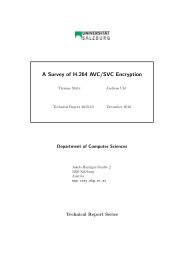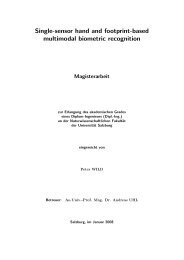Pit Pattern Classification in Colonoscopy using Wavelets - WaveLab
Pit Pattern Classification in Colonoscopy using Wavelets - WaveLab
Pit Pattern Classification in Colonoscopy using Wavelets - WaveLab
You also want an ePaper? Increase the reach of your titles
YUMPU automatically turns print PDFs into web optimized ePapers that Google loves.
4 Automated pit pattern<br />
classification<br />
4.1 Introduction<br />
In order to succeed, your desire for success<br />
should be greater than your fear of failure.<br />
- Bill Cosby<br />
Based on the prelim<strong>in</strong>aries <strong>in</strong>troduced <strong>in</strong> the last two chapters this chapter now presents<br />
methods we developed for an automated classification of pit pattern images. We describe<br />
a few techniques and algorithms to extract features from image data and how to perform a<br />
classification based on these features. Additionally this chapter <strong>in</strong>troduces two classification<br />
schemes without any wavelet subband feature extraction <strong>in</strong>volved.<br />
4.2 <strong>Classification</strong> based on features<br />
The methods presented <strong>in</strong> this section first extract feature vectors from the images used,<br />
which are then used to tra<strong>in</strong> classifiers. The used classifiers and the process of classifier<br />
tra<strong>in</strong><strong>in</strong>g and classification is then further described <strong>in</strong> section 4.4.<br />
4.2.1 Feature extraction<br />
4.2.1.1 Best-basis method (BB)<br />
In section 2.6.1 two different methods for basis selection have been presented. The classification<br />
scheme presented <strong>in</strong> this section is based on the best-basis algorithm, which, as<br />
already stated before, is primarily used for compression of image data. This approach however<br />
uses the best basis algorithm to try to classify image data.<br />
Dur<strong>in</strong>g the tra<strong>in</strong><strong>in</strong>g process all images <strong>in</strong> I T are decomposed to obta<strong>in</strong> the wavelet packet<br />
coefficients for each image. Additionally dur<strong>in</strong>g the decomposition some cost <strong>in</strong>formation<br />
is stored along with each node of the respective quadtree. This cost <strong>in</strong>formation is based<br />
on the chosen cost function and is used to determ<strong>in</strong>e the importance of a subband for the<br />
35








